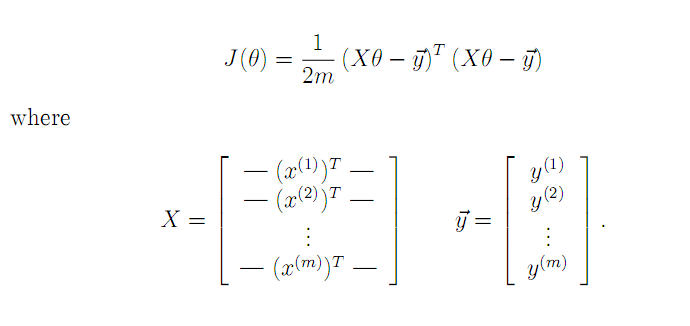如果需要代做算法,可以联系我...博客右侧有联系方式。
一、相关概念
1.梯度下降

由于Z= X*theta - y是列向量,所以Z'*Z就是平方和连加,就是2范数;如果Z是矩阵呢,那么Z'*Z的对角线就是Z矩阵每列的2范数。
2.正规方程(Normal Equation)
θ = (XTX)-1XTY。
二、代码实现
2104,3,399900
1600,3,329900
2400,3,369000
1416,2,232000
3000,4,539900
1985,4,299900
1534,3,314900
1427,3,198999
1380,3,212000
1494,3,242500
1940,4,239999
2000,3,347000
1890,3,329999
4478,5,699900
1268,3,259900
2300,4,449900
1320,2,299900
1236,3,199900
2609,4,499998
3031,4,599000
1767,3,252900
1888,2,255000
1604,3,242900
1962,4,259900
3890,3,573900
1100,3,249900
1458,3,464500
2526,3,469000
2200,3,475000
2637,3,299900
1839,2,349900
1000,1,169900
2040,4,314900
3137,3,579900
1811,4,285900
1437,3,249900
1239,3,229900
2132,4,345000
4215,4,549000
2162,4,287000
1664,2,368500
2238,3,329900
2567,4,314000
1200,3,299000
852,2,179900
1852,4,299900
1203,3,239500
......................
%% Clear and Close Figures
clear ; close all; clc
data = load('ex1data2.txt');
X = data(:, 1:2);
y = data(:, 3);
m = length(y);
% Scale features and set them to zero mean
%不对Y 规范化
[X mu sigma] = featureNormalize(X);
% Add intercept term to X
%为了矩阵的形式(theta0) theta'*X
X = [ones(m, 1) X];
%% ================ Part 2: Gradient Descent ================
alpha = 0.01;
num_iters = 400;
theta = zeros(3, 1);
[theta, J_history] = gradientDescentMulti(X, y, theta, alpha, num_iters);
%convergence : 收敛
% Plot the convergence graph
figure;
%numel 矩阵中元素个数
plot(1:numel(J_history), J_history, '-b', 'LineWidth', 2);
xlabel('Number of iterations');
ylabel('Cost J');
% Display gradient descent's result
fprintf('Theta computed from gradient descent:
');
fprintf(' %f
', theta);
fprintf('
');
% Estimate the price of a 1650 sq-ft, 3 br house
% ====================== YOUR CODE HERE ======================
% Recall that the first column of X is all-ones. Thus, it does
% not need to be normalized.
price = 0; % You should change this
Xp = [1 1650 3];
Xp = [Xp(1),(Xp(2) - mu(1))/sigma(1),(Xp(3) - mu(2))/sigma(2)];
price = Xp*theta;
fprintf(['Predicted price of a 1650 sq-ft, 3 br house ' ...
'(using gradient descent):
$%f
'], price);
%% ================ Part 3: Normal Equations ================
data = csvread('ex1data2.txt');
X = data(:, 1:2);
y = data(:, 3);
m = length(y);
% Add intercept term to X
X = [ones(m, 1) X];
% Calculate the parameters from the normal equation
theta = normalEqn(X, y);
% Display normal equation's result
fprintf('Theta computed from the normal equations:
');
fprintf(' %f
', theta);
fprintf('
');
% Estimate the price of a 1650 sq-ft, 3 br house
% ====================== YOUR CODE HERE ======================
price = 0; % You should change this
Xexample = [1 1650 3];
price = Xexample*theta;
fprintf(['Predicted price of a 1650 sq-ft, 3 br house ' ...
'(using normal equations):
$%f
'], price);
...............
function [theta] = normalEqn(X, y)
%NORMALEQN Computes the closed-form solution to linear regression
% NORMALEQN(X,y) computes the closed-form solution to linear
% regression using the normal equations.
theta = zeros(size(X, 2), 1);
% 1.对于方阵A,如果为非奇异方阵,则存在逆矩阵inv(A)
% 2.对于奇异矩阵或者非方阵,并不存在逆矩阵,但可以使用pinv(A)求其伪逆
%
% 很多时候你不需要求逆矩阵,例如
% inv(A)*B
% 实际上可以写成
% AB
% B*inv(A)
% 实际上可以写成
% B/A
% 这样比求逆之后带入精度要高
theta = pinv((X'*X))*X'*y;
end
..............
function [theta, J_history] = gradientDescentMulti(X, y, theta, alpha, num_iters)
% Initialize some useful values
m = length(y); % number of training examples
J_history = zeros(num_iters, 1);
for iter = 1:num_iters
%theta 是 3*1 是列向量 X的第一列是1 恰好乘以theta0
% (1*3 X 3*47 - 1*47)'*
theta = theta - alpha * ((theta'*X'-y')*X)'/m;
% Save the cost J in every iteration
J_history(iter) = computeCostMulti(X, y, theta);
end
end
..........
function J = computeCostMulti(X, y, theta)
% Initialize some useful values
m = length(y); % number of training examples
J = 0;
J = sum(((theta'*(X')-y').^2))/(2*m);
end
三、结果
1.代价函数

2.预测结果
Theta computed from gradient descent:
334302.063993
100087.116006
3673.548451
Predicted price of a 1650 sq-ft, 3 br house (using gradient descent):
$289314.620338
Theta computed from the normal equations:
89597.909545
139.210674
-8738.019113
Predicted price of a 1650 sq-ft, 3 br house (using normal equations):
$293081.464335